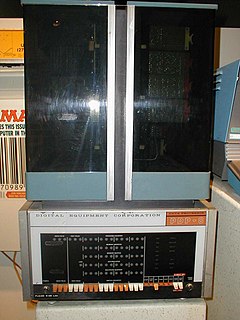 W
WA minicomputer, or colloquially mini, is a class of smaller computers that was developed in the mid-1960s and sold for much less than mainframe and mid-size computers from IBM and its direct competitors. In a 1970 survey, The New York Times suggested a consensus definition of a minicomputer as a machine costing less than US$25,000, with an input-output device such as a teleprinter and at least four thousand words of memory, that is capable of running programs in a higher level language, such as Fortran or BASIC.
 W
WA superminicomputer, colloquially supermini, was a high-end minicomputer. The term was used to distinguish the emerging 32-bit architecture midrange computers introduced in the mid to late 1970s from the classical 16-bit systems that preceded them. The development of these computers was driven by the need of applications to address larger memory. The term midicomputer had been used earlier to refer to these systems. Virtual memory was often an additional criteria that was considered for inclusion in this class of system. The computational speed of these machines was significantly greater than the 16-bit mincomputers and approached the performance of small mainframe computers. The name has at times been described as a "frivolous" term created by "marketeers" that lacks a specific definition. Describing a class of system has historically been seen as problematic: "In the computer kingdom, taxonomic classification of equipment is more of a black art than a science." There is some diagreement about which systems should be included in this class. The origin of the name is uncertain.
 W
WThe 3B series computers are a line of minicomputers that were produced by AT&T Computer Systems' Western Electric subsidiary for use with the company's UNIX operating system and its in-house micro-programmed central processing units. The line primarily consists of the models 3B20, 3B5, 3B15, 3B2, and 3B4000. The series is notable for controlling a series of electronic switching systems (ESS) for telecommunication, for general computing purposes, and for serving as the historical software porting base for commercial UNIX.
 W
WThe Bendix G-15 is a computer introduced in 1956 by the Bendix Corporation, Computer Division, Los Angeles, California. It is about 5 by 3 by 3 feet and weighs about 966 pounds (438 kg). The G-15 has a drum memory of 2,160 29-bit words, along with 20 words used for special purposes and rapid-access storage. The base system, without peripherals, cost $49,500. A working model cost around $60,000. It could also be rented for $1,485 per month. It was meant for scientific and industrial markets. The series was gradually discontinued when Control Data Corporation took over the Bendix computer division in 1963.
 W
WThe Data General Eclipse line of computers by Data General were 16-bit minicomputers released in early 1974 and sold until 1988. The Eclipse was based on many of the same concepts as the Data General Nova, but included support for virtual memory and multitasking more suitable to the small office than the lab. It was also packaged differently for this reason, in a floor-standing case the size of a small refrigerator.
 W
WThe Data General Nova is a series of 16-bit minicomputers released by the American company Data General. The Nova family was very popular in the 1970s and ultimately sold tens of thousands of examples.
 W
WThe PDP-11 is a series of 16-bit minicomputers sold by Digital Equipment Corporation (DEC) from 1970 into the 1990s, one of a set of products in the Programmed Data Processor (PDP) series. In total, around 600,000 PDP-11s of all models were sold, making it one of DEC's most successful product lines. The PDP-11 is considered by some experts to be the most popular minicomputer.
 W
WFlip-Chip electronic modules were components of digital logic systems made by the Digital Equipment Corporation (DEC) for its PDP-7, PDP-8, PDP-9, and PDP-10, beginning on August 24, 1964. The trademark "Flip-Chip"' was filed on August 27, 1964. Various manuals produced by DEC refer to the modules as "FLIP CHIP", "FLIP-CHIP", "Flip Chip", and "Flip-Chip", with trademark and registered trademark symbols.
 W
WThe GEC 4000 was a series of 16/32-bit minicomputers produced by GEC Computers Ltd in the United Kingdom during the 1970s, 1980s and early 1990s.
 W
WGEC Computers Limited was a British computer manufacturing company under the GEC holding company from 1968 until the 1990s.
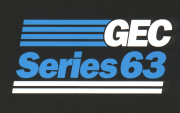 W
WThe GEC Series 63 was a 32-bit minicomputer produced by GEC Computers Limited of the UK during the 1980s in conjunction with A.B. Dick in USA. During development, the computer was known as the R Project. The hardware development was done in Scottsdale, Arizona whilst the software was the responsibility of GEC in Dunstable, UK. The hardware made early use of pipeline concepts, processing one instruction whilst completing the preceding one.
 W
WThe Honeywell 316 was a popular 16-bit minicomputer built by Honeywell starting in 1969. It is part of the Series 16, which includes the Models 116, 316 (1969), 416 (1966), 516 (1966) and DDP-716 (1969). They were commonly used for data acquisition and control, remote message concentration, clinical laboratory systems, Remote Job Entry and time-sharing. The Series-16 computers are all based on the DDP-116 designed by Gardner Hendrie at Computer Control Company, Inc. (3C) in 1964.
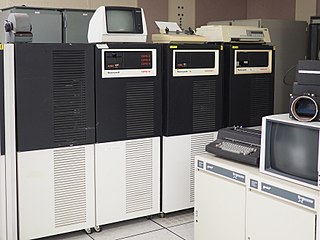 W
WThe Honeywell Level 6 was a line of 16-bit minicomputers, later upgraded to 32-bit, manufactured by Honeywell, Inc. from the mid 1970s. In 1979 the Level 6 was renamed the DPS 6, subsequently DPS 6 Plus and finally DPS 6000.
 W
WThe HP 2100 is a series of 16-bit minicomputers that were produced by Hewlett-Packard (HP) from the mid-1960s to early 1990s. Tens of thousands of machines in the series were sold over its twenty-five year lifetime, making HP the fourth largest minicomputer vendor during the 1970s.
 W
WK-202 was a 16-bit minicomputer, created by a team led by Polish scientist Jacek Karpiński between 1970–1973 in cooperation with British companies Data-Loop and M.B. Metals. Approximately 30 units were claimed to be produced. All units shipped to M.B. Metals were returned for service. Due to friction resulting from competition with Elwro, a government-backed competitor, the production of K-202 was blocked and Karpiński thrown out of his company under the allegations of sabotage and embezzlement.
 W
WThe LINC is a 12-bit, 2048-word transistorized computer. The LINC is considered by some the first minicomputer and a forerunner to the personal computer. Originally named the "Linc", suggesting the project's origins at MIT's Lincoln Laboratory, it was renamed LINC after the project moved from the Lincoln Laboratory. The LINC was designed by Wesley A. Clark and Charles Molnar.
 W
WLINC-8 was the name of a minicomputer manufactured by Digital Equipment Corporation between 1966 and 1969. It combined a LINC computer with a PDP-8 in one cabinet, thus being able to run programs written for either of the two architectures.
 W
WThe MAC-16 was a 16-bit minicomputer introduced in 1969 by Lockheed Electronics. One main selling point of the MAC-16 was a dedicated context switching system that completed operations in two machine cycles. Several improved versions were introduced, including the MAC Jr., Sue, and System III, but the company dropped support for all of these in the late 1970s.
 W
WMERA 300 was a Polish-built 8-bit minicomputer family. It was first introduced in 1974 at the Poznań Trade Fair and Exhibition.
 W
WMIR (Russian:МИР) is a series of early Soviet transistorized minicomputers. It was developed from 1965 (MIR), 1968 (MIR-1) to 1969 (MIR-2). The development team was led by Victor Glushkov.
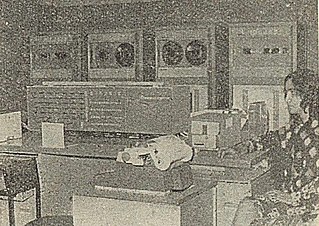 W
WThe first Nairi computer was developed and launched into production in 1964, at the Yerevan Research Institute of Mathematical Machines, and were chiefly designed by Rachya E. Hovsepyan. In 1965, a modified version called Nairi-M, and in 1967 versions called Nairi-S and Nairi-2, were developed. Nairi-3 and Nairi-3-1, which used integrated hybrid chips, were developed in 1970. These computers were used for a wide class of tasks in a variety of areas, including Mechanical Engineering and the Economics.
 W
WNorsk Data was a minicomputer manufacturer located in Oslo, Norway. Existing from 1967 to 1992, it had its most active period from the early 1970s to the late 1980s. At the company's peak in 1987 it was the second largest company in Norway and employed over 4,500 people.
 W
WThe PDP-1 is the first computer in Digital Equipment Corporation's PDP series and was first produced in 1959. It is famous for being the computer most important in the creation of hacker culture at MIT, BBN and elsewhere. The PDP-1 is the original hardware for playing history's first game on a minicomputer, Steve Russell's Spacewar!
 W
WThe PDP-4 was the successor to the Digital Equipment Corporation's PDP-1.
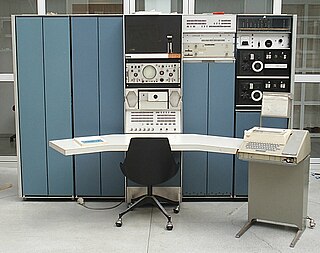 W
WThe PDP-7 was a minicomputer produced by Digital Equipment Corporation as part of the PDP series. Introduced in 1964, shipped since 1965, it was the first to use their Flip-Chip technology. With a cost of US$72,000, it was cheap but powerful by the standards of the time. The PDP-7 is the third of Digital's 18-bit machines, with essentially the same instruction set architecture as the PDP-4 and the PDP-9.
 W
WThe PDP-8 is a 12-bit minicomputer that was produced by Digital Equipment Corporation (DEC). It was the first commercially successful minicomputer, with over 50,000 units being sold over the model's lifetime. Its basic design follows the pioneering LINC but has a smaller instruction set, which is an expanded version of the PDP-5 instruction set. Similar machines from DEC are the PDP-12 which is a modernized version of the PDP-8 and LINC concepts, and the PDP-14 industrial controller system.
 W
WThe PDP-11 is a series of 16-bit minicomputers sold by Digital Equipment Corporation (DEC) from 1970 into the 1990s, one of a set of products in the Programmed Data Processor (PDP) series. In total, around 600,000 PDP-11s of all models were sold, making it one of DEC's most successful product lines. The PDP-11 is considered by some experts to be the most popular minicomputer.
 W
WThe PDP-15 was the fifth and last of the 18-bit minicomputers produced by Digital Equipment Corporation. The PDP-1 was first delivered in December 1959 and the first PDP-15 was delivered in February 1970. More than 400 of these successors to the PDP-9 were ordered within the first eight months.
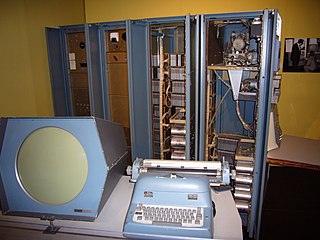 W
WProgrammed Data Processor (PDP), referred to by some customers, media and authors as "Programmable Data Processor, is a term used by the Digital Equipment Corporation from 1957 to 1990 for several lines of minicomputers. The name "PDP" intentionally avoids the use of the term "computer" because, at the time of the first PDPs, computers had a reputation of being large, complicated, and expensive machines, and the venture capitalists behind Digital would not support Digital's attempting to build a "computer"; the word "minicomputer" had not yet been coined. So instead, Digital used their existing line of logic modules to build a Programmed Data Processor and aimed it at a market that could not afford the larger computers.
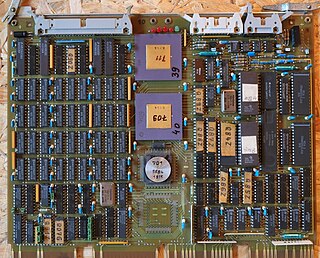 W
WThe K 1820, full name RVS K 1820, cipher in the SM EVM of the former COMECON countries SM 1720, was a workstation developed in East Germany. VEB Robotron Elektronik Dresden began development of the K 1820 in 1986 and it went into serial production in 1990.
 W
WThe K 1840, full name RVS K 1840 was a minicomputer from the German Democratic Republic (GDR). Its development began in August 1985 at VEB Robotron Elektronik in Dresden, and it went into production in 1988.
 W
WThe Singer System Ten was a small-business computer manufactured by the Singer Corporation. The System Ten, introduced in 1970, featured an early form of logical partitioning. The System Ten was a character-oriented computer, using 6-bit BCD characters and decimal arithmetic.
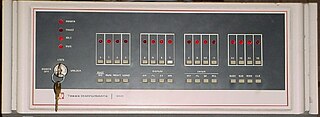 W
WThe TI-990 was a series of 16-bit minicomputers sold by Texas Instruments (TI) in the 1970s and 1980s. The TI-990 was a replacement for TI's earlier minicomputer systems, the TI-960 and the TI-980. It had several unique features, and was easier to program than its predecessors.
 W
WVAX is a line of superminicomputers and workstations developed by the Digital Equipment Corporation (DEC) in the mid-1970s. The VAX-11/780, introduced October 25, 1977, was the first of a range of popular and influential computers implementing the VAX instruction set architecture (ISA). Over 100 models were introduced over the lifetime of the design, with the last members arriving in the early 1990s. The VAX was succeeded by the DEC Alpha, which included several features from VAX machines to make porting from the VAX easier.
 W
WThe VAXBI bus is a computer bus designed and sold by the Digital Equipment Corporation (DEC) of Maynard, Massachusetts.
 W
WThe Wang 2200 appeared in May 1973, and was Wang Laboratories' first minicomputer that could perform data processing in a common computer language. Unlike some other desktop computers, such as the HP 9830, it had a cathode ray tube (CRT) in a cabinet that also included an integrated computer-controlled cassette tape storage unit and keyboard. Microcoded to run interpretive BASIC, about 65,000 systems were shipped in its lifetime and it found wide use in small and medium-size businesses worldwide.
 W
WWang Laboratories was a computer company founded in 1951, by An Wang and G. Y. Chu. The company was successively headquartered in Cambridge, Massachusetts (1954–1963), Tewksbury, Massachusetts (1963–1976), and finally in Lowell, Massachusetts (1976–1997). At its peak in the 1980s, Wang Laboratories had annual revenues of $3 billion and employed over 33,000 people. It was one of the leading companies during the time of the Massachusetts Miracle.
 W
WXylogics or Xylogic Systems was started in 1970 by three former NASA employees. The company was originally named Xynetic Systems, but this name was already in use by a California company, so the group in Needham, MA changed their name in late 1970 to Xylogic Systems. Their original business was the design and development of computerized newspaper typesetting and editing systems. The first system was developed for the Daytona Beach News Journal, with the Farmington, NM newspaper getting the second system. By 1972, Xylogics had grown to more than 15 people, and moved to Natick, MA. The company used the GRI mini-computer, and custom designed many circuit boards to support disk drives, paper tape punches and readers, and automatic capture of newswire service feeds. By 1974, the company had developed a CRT editing station, and offered systems of up to 4 computers and more than 50 terminals for newspaper or in-plant publishing to perform editing and typesetting. About this time, a second division was created to design and build disk controllers for DEC computers, derived in part from the successful designs and manufacturing capability developed for the newspaper business. In 1976, a major customer of Xylogics, Dymo Graphics Systems, purchased the newspaper product line and hired most of the original developers. Dymo Graphics, of Wilmington, MA was the first company to develop laser technology for typesetting applications. Dymo Graphic Systems combined their typesetting equipment business with the Xylogics editing systems, and by 1978 had over 100 turnkey typesetting systems in use worldwide. The Xylogic Systems typesetting capability was the first with WYSIWYG printing capability for Tabloid size page layout, and later full page layout. Capability included on-line classified ad capture with automated pricing, in addition to full page markup and typesetting. In 1977, Dymo was purchased by Eselte Corporation, who wanted control of the highly successful "Dymo Label Maker" consumer product. Eselte sold the newspaper and typesetting business to ITEK corporation in 1978, who wanted the laser technology IP. ITEK declined support to the newspaper and typesetting business, and in 1979, the newspaper product development and manufacturing staff of 150 engineers, technicians, assemblers, and field support personnel had dwindled to 2 by January, 1980.